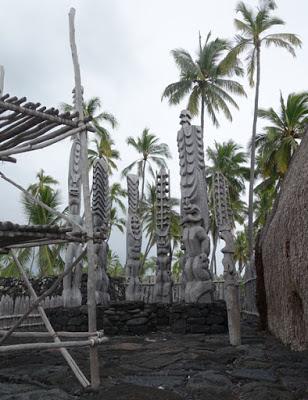 When I am on the Big Island of Hawaii, one of my favorite places to visit is Pu’uhonua o Honaunau, or the Place of Refuge, a 45 minute drive south of Kona. At the edge of the ocean, it is the perfect place for a picnic lunch, exploring tide pools, and learning about ancient Hawaiian culture. Once a sacred spot, it is now a National Historical Park.
When I am on the Big Island of Hawaii, one of my favorite places to visit is Pu’uhonua o Honaunau, or the Place of Refuge, a 45 minute drive south of Kona. At the edge of the ocean, it is the perfect place for a picnic lunch, exploring tide pools, and learning about ancient Hawaiian culture. Once a sacred spot, it is now a National Historical Park.
Coconut palms line the shore in the Place of Refuge
On our recent visit to Hawaii we spent an afternoon there. After listening to an introductory talk from a park ranger, we explored the grounds on our own following the numbered posts that were explained in our brochure.
Carved figures guard the heiau (temple) where the bones of 23 chiefs are contained.
We learned that the first Polynesians arrived in Hawaii about a thousand years ago. People settled the islands and lived in family groups governed by chiefs or alii. Complex rules or kapu governed every aspect of life. If kapu was broken the punishment was death. BUT if the person could make to a designated place of refuge or Pu’uhonua, a priest could cleanse the sins and the person could return to village life. During times of war the Pu’uhonua was also a sanctuary for children, elders and noncombatants. Defeated warriors could also seek safety in the refuge. When the battle was over, they returned home.
This 12 foot high stone wall, built without mortar, divides the royal grounds from the Place of Refuge
There are two main parts to the park–the royal grounds, which is where the priests lived, and the Pu’uhonua or Place of Refuge.
Fish pond in the royal grounds
In the royal grounds there are several shallow ponds that were used to keep fish for the royal menu. As we looked into the water we could see dozens of circular depressions in the bottom of the pond, each occupied by a pair of fish. These were their nests.
Each circular nest is guarded fiercely by its occupants
Before metal was introduced to Hawaii by Europeans, tools and building materials were made of stone, wood, shells and other natural materials.

Small holes carved in the surface of this rock were used for playing a strategy game called konane. It is played with black and white pebbles.
Complex rules governed ancient Hawaiian society. In the time of kapu, examples of infractions included a man eating with a woman, a fisherman catching a fish out of season, or a commoner casting his shadow on a chief. In 1819 the tradition of kapu ended and the places of refuge were no longer necessary. Elsewhere on the Hawaiian islands were other Places of Refuge. This is the only one that has been preserved.